
The Tower
Liberties
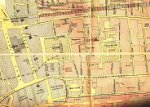
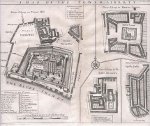
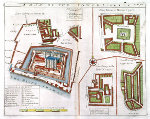 See here for the history of the areas
that became part of the
Liberties of the Tower of London.
By Letters Patent of 1686, King James II
included the areas of Minories, the Old Artillery Ground and
Wellclose among the Tower
Liberties, although the Tower held
no
land in the area. Right [b+w
version is in higher resolution] is
Stow / Strype's map of c1720 showing the areas involved (Wellclose
Square, formerly known
as Marine Square, is in the top right), and part of the 1878 Vestry
map. The western edge of the
Precinct of Wellclose was
Well Street [now Ensign Street], its southern edge Neptune Street [now
Wellclose Street], and
to the north was Graces Alley, later home to Wilton's Music Hall. See also Rosemary Lane
[now Royal Mint Street].
See here for the history of the areas
that became part of the
Liberties of the Tower of London.
By Letters Patent of 1686, King James II
included the areas of Minories, the Old Artillery Ground and
Wellclose among the Tower
Liberties, although the Tower held
no
land in the area. Right [b+w
version is in higher resolution] is
Stow / Strype's map of c1720 showing the areas involved (Wellclose
Square, formerly known
as Marine Square, is in the top right), and part of the 1878 Vestry
map. The western edge of the
Precinct of Wellclose was
Well Street [now Ensign Street], its southern edge Neptune Street [now
Wellclose Street], and
to the north was Graces Alley, later home to Wilton's Music Hall. See also Rosemary Lane
[now Royal Mint Street].
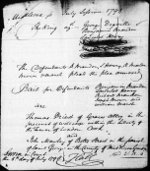 What
were the implications of this 'Liberty'? It meant
that authority
for the maintenance of law and order within the area lay with the
Governor of the Tower, sitting with appointed magistrates. They dealt
with all criminal charges, great and small, and those accused
were committed to Newgate for safe custody. In civil matters,
it
served as a Court of Record and Request for
the recovery of small debts (like
a modern-day
County Court), and had its own 'gaol of the Tower Royalty'. An example
of this alternative jurisdiction is from 1798, when at the Middlesex
sessions in July a group of men (including Lancelot Henry,
later a
churchwarden at St George-in-the-East) stood accused of crimes (which
they denied), and were bailed, but claimed that as the alleged events
occurred within the Liberty the quarter sessions had no authority to
hear the case. (Click here for documents and transcript:
we don't know the nature of the charges or the final
verdict.)
What
were the implications of this 'Liberty'? It meant
that authority
for the maintenance of law and order within the area lay with the
Governor of the Tower, sitting with appointed magistrates. They dealt
with all criminal charges, great and small, and those accused
were committed to Newgate for safe custody. In civil matters,
it
served as a Court of Record and Request for
the recovery of small debts (like
a modern-day
County Court), and had its own 'gaol of the Tower Royalty'. An example
of this alternative jurisdiction is from 1798, when at the Middlesex
sessions in July a group of men (including Lancelot Henry,
later a
churchwarden at St George-in-the-East) stood accused of crimes (which
they denied), and were bailed, but claimed that as the alleged events
occurred within the Liberty the quarter sessions had no authority to
hear the case. (Click here for documents and transcript:
we don't know the nature of the charges or the final
verdict.)
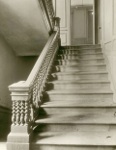
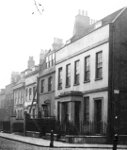
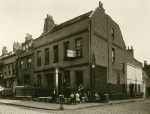
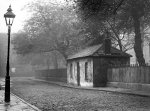 The Court House, on the south side of
Wellclose Square at the corner with Neptune Street was erected some
time after 1687, and there are good records and pictures of the
building before demolition, including Barbon's staircase to the first
floor. (In its latter years it was used as
a German club, and then became a
paint works - the courtroom became a storeroom, and the staircase was
painted in shiny cocoa brown.) The prison behind, on
the
corner of Neptune [later Wellclose] Street, was
commonly known as the 'Sly House', because it was said that felons who
entered
it left by a subterranean passage to the Tower and the docks, from
which the convict ship Success
left. The
reality may have been more prosaic: it was used mainly for debtors who
were tried at the local court. Right
is the Watch House in
the Square, c1925, used in earlier times by the nightwatchmen.
The Court House, on the south side of
Wellclose Square at the corner with Neptune Street was erected some
time after 1687, and there are good records and pictures of the
building before demolition, including Barbon's staircase to the first
floor. (In its latter years it was used as
a German club, and then became a
paint works - the courtroom became a storeroom, and the staircase was
painted in shiny cocoa brown.) The prison behind, on
the
corner of Neptune [later Wellclose] Street, was
commonly known as the 'Sly House', because it was said that felons who
entered
it left by a subterranean passage to the Tower and the docks, from
which the convict ship Success
left. The
reality may have been more prosaic: it was used mainly for debtors who
were tried at the local court. Right
is the Watch House in
the Square, c1925, used in earlier times by the nightwatchmen.
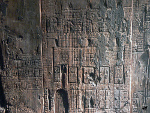
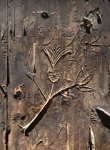 The landlord of the
adjacent King's Arms (33
Wellclose Square, linked to what later became 211 St George Street) was
responsible for feeding the prisoners: a doorway beside its main
entrance led up a stone staircase to the first floor of the Court
House, and down to a courtyard and the prison. When the prison closed and the King's
Arms took
over the site, the landlord would open the cells, with their
heavily-bolted doors, grilles, plank beds, fetters and straitjackets,
to visitors. Some of these fixtures have now been preserved at the
Museum of
London, including inscriptions scratched with pine cones on the
wooden panels [right]. Among
them is one to Stockley, who invented the 'pitch
plaster'
which was clapped on victims' mouths to keep them silent; the
optimistic verse The
cupboard is empty, to our sorrow; let's hope it will be full to-morrow; and the pathetic
plea Please
to remember the poor debtors, 1758. As many
advertisements in the Times
show, in the 18th and early 19th centuries estate agents regularly left
prospectuses for East London properties (often sold by auction at Garraway's Coffee House
in the City) at the King's Arms.
The freehold was sold in the 1880s, with Thomas Wasmuth as sitting
tenant and licensee (at least one of his children was baptized at St
George-in-the-East). It was demolished around 1912.
The landlord of the
adjacent King's Arms (33
Wellclose Square, linked to what later became 211 St George Street) was
responsible for feeding the prisoners: a doorway beside its main
entrance led up a stone staircase to the first floor of the Court
House, and down to a courtyard and the prison. When the prison closed and the King's
Arms took
over the site, the landlord would open the cells, with their
heavily-bolted doors, grilles, plank beds, fetters and straitjackets,
to visitors. Some of these fixtures have now been preserved at the
Museum of
London, including inscriptions scratched with pine cones on the
wooden panels [right]. Among
them is one to Stockley, who invented the 'pitch
plaster'
which was clapped on victims' mouths to keep them silent; the
optimistic verse The
cupboard is empty, to our sorrow; let's hope it will be full to-morrow; and the pathetic
plea Please
to remember the poor debtors, 1758. As many
advertisements in the Times
show, in the 18th and early 19th centuries estate agents regularly left
prospectuses for East London properties (often sold by auction at Garraway's Coffee House
in the City) at the King's Arms.
The freehold was sold in the 1880s, with Thomas Wasmuth as sitting
tenant and licensee (at least one of his children was baptized at St
George-in-the-East). It was demolished around 1912.
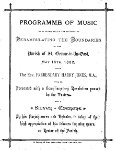 The
Precinct's distinctive legal status gradually came to an end as new
local government legislation took
effect: from 1855 (or earlier) the area fell under the jurisdiction of
the local Magistrates' Court. But
the traditional
triennial Beating
of the
Bounds,
on Ascension Day, continued until
1897 for the Liberty of Wellclose. The Lieutenant of the
Tower came,
accompanied by an escort of Tower warders, followed by officials and
schoolboys wearing ribbons
red, white and blue on their bosoms, and carrying willow
wands. These boys were the sons of soldiers quartered at the
Tower. Many
parish churches, including St George's, also used
to beat the
bounds,
perambulating the borders with hymns and prayers - as this 1882
programme [left]
shows:
the event was also a farewell to Harry Jones as Rector. Right is a 1910 picture
from the
Tower's own ceremony from 1910. The
tradition continues in some places, though with no legal significance; it was revived for a few years by Fr Aquinas at St Paul Dock Street in the 1970s.
The
Precinct's distinctive legal status gradually came to an end as new
local government legislation took
effect: from 1855 (or earlier) the area fell under the jurisdiction of
the local Magistrates' Court. But
the traditional
triennial Beating
of the
Bounds,
on Ascension Day, continued until
1897 for the Liberty of Wellclose. The Lieutenant of the
Tower came,
accompanied by an escort of Tower warders, followed by officials and
schoolboys wearing ribbons
red, white and blue on their bosoms, and carrying willow
wands. These boys were the sons of soldiers quartered at the
Tower. Many
parish churches, including St George's, also used
to beat the
bounds,
perambulating the borders with hymns and prayers - as this 1882
programme [left]
shows:
the event was also a farewell to Harry Jones as Rector. Right is a 1910 picture
from the
Tower's own ceremony from 1910. The
tradition continues in some places, though with no legal significance; it was revived for a few years by Fr Aquinas at St Paul Dock Street in the 1970s.
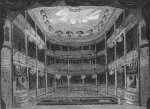
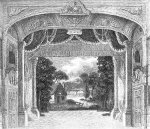 The
Royalty
Theatre [left] in
Well Street was
built by subscription in 1786 and run by John 'Plausible' Palmer - a
man of the most versatile and
eminent talents, but destitute of prudence - but was not
licensed. After the opening
performances of As You Like It and
the farce Miss in her Teens, the
profits given to the new London Hospital, it closed until a licence for
the hybrid musical entertainments permitted by law - interludes, pantomimes
and other species of the irregular drama - was granted.
Later
it fell into the hands of various
adventurers (Nightingale, London and
Middlesex 1815).
At some point a gasworks (with a 'gasometer') was built north of the
theatre, next to the stage, to provide lighting both for the theatre
(Palmer's brother Robert had taken part in a display of an 'Aeropyric
Branch' at the Lyceum in 1789 which was probably a demonstration of gas
lighting) and for the neighbourhood, a prosperous manufacturing district, at
an annual profit of £1,000. The Chartered Gas, Light & Coke Co.
bought this 'East London Gas Works' plus the theatre at auction in
1820. In April 1826 the scenery above the stage caught fire during a
performance of Kendrick the Accursed,
for which half a pound of powder was used to simulate the eruption of
Mount Etna; apparently the gas lights beside the stage had not been
turned off.
The
Royalty
Theatre [left] in
Well Street was
built by subscription in 1786 and run by John 'Plausible' Palmer - a
man of the most versatile and
eminent talents, but destitute of prudence - but was not
licensed. After the opening
performances of As You Like It and
the farce Miss in her Teens, the
profits given to the new London Hospital, it closed until a licence for
the hybrid musical entertainments permitted by law - interludes, pantomimes
and other species of the irregular drama - was granted.
Later
it fell into the hands of various
adventurers (Nightingale, London and
Middlesex 1815).
At some point a gasworks (with a 'gasometer') was built north of the
theatre, next to the stage, to provide lighting both for the theatre
(Palmer's brother Robert had taken part in a display of an 'Aeropyric
Branch' at the Lyceum in 1789 which was probably a demonstration of gas
lighting) and for the neighbourhood, a prosperous manufacturing district, at
an annual profit of £1,000. The Chartered Gas, Light & Coke Co.
bought this 'East London Gas Works' plus the theatre at auction in
1820. In April 1826 the scenery above the stage caught fire during a
performance of Kendrick the Accursed,
for which half a pound of powder was used to simulate the eruption of
Mount Etna; apparently the gas lights beside the stage had not been
turned off. 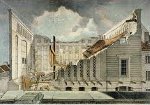
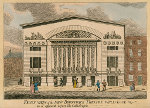 The
firemen could only stand at either
end of the theatre and throw the water on the flames
as well as they could; there was more concern about the two
adjacent sugar refineries. All that survived was the grand piano snatched from the green room by an unknown
sailor. A
replacement building, the Royal Brunswick [right], was erected in seven months, with
a heavy iron
roof. A few days after it opened on 28 February 1828, during a
rehearsal of Guy Mannering, the
roof fell
in, crushing to death Mr Maurice, one of the proprietors, and twelve
others. See here
for the story of the acquisition of the site for the Sailors' Home.
The
firemen could only stand at either
end of the theatre and throw the water on the flames
as well as they could; there was more concern about the two
adjacent sugar refineries. All that survived was the grand piano snatched from the green room by an unknown
sailor. A
replacement building, the Royal Brunswick [right], was erected in seven months, with
a heavy iron
roof. A few days after it opened on 28 February 1828, during a
rehearsal of Guy Mannering, the
roof fell
in, crushing to death Mr Maurice, one of the proprietors, and twelve
others. See here
for the story of the acquisition of the site for the Sailors' Home.

 In a district where
most building projects were piecemeal and chaotic, Wellclose Square
(originally known as Marine Square) and the smaller Prince's
Square to the east were the
only planned developments of their time, and even here (as noted below)
the houses were of various periods, and were constantly being modified,
extended and rebuilt. Nicholas Barbon
(c1640-98) was its principal developer. His full name was Nicholas
If-Jesus-Christ-Had-Not-Died-For-Thee-Thou-Hadst-Been-Damned Barbon,
given by his Puritan father Praisegod
Barbon (Barebone), leather-seller,
MP, fanatical anti-monarchist and general nuisance. Returning
from Holland in the 1670s, Nicholas was a major speculator in the West
End, leasing plots from the Crown
in the aftermath of the Great Fire of London, seeing an opportunity to
provide houses for well-to-do
merchants. He also acquired three sites in East London, paying £3,200
for the freehold of Wellclose Square (though he was slow in making
payment). In 1682-3 he cleared the site and laid out a square with
diagonal passageways at each corner, to insulate it from the noise and
dirt of the surrounding area and maximise the frontages. (Of these
passageways, only Grace's Alley on the NW corner remains, plus the now
un-named cut-through on the SW, variously known in the 19th century as
Harrrod's, Harad's, Harrald's and Hard's Court or Place; Ship Alley on
the SE corner and North East Passage have disappeared. Shorter [now
Fletcher] and Neptune [now Wellclose] Streets connected the square
respectively to Cable Street
and The Highway.)
In a district where
most building projects were piecemeal and chaotic, Wellclose Square
(originally known as Marine Square) and the smaller Prince's
Square to the east were the
only planned developments of their time, and even here (as noted below)
the houses were of various periods, and were constantly being modified,
extended and rebuilt. Nicholas Barbon
(c1640-98) was its principal developer. His full name was Nicholas
If-Jesus-Christ-Had-Not-Died-For-Thee-Thou-Hadst-Been-Damned Barbon,
given by his Puritan father Praisegod
Barbon (Barebone), leather-seller,
MP, fanatical anti-monarchist and general nuisance. Returning
from Holland in the 1670s, Nicholas was a major speculator in the West
End, leasing plots from the Crown
in the aftermath of the Great Fire of London, seeing an opportunity to
provide houses for well-to-do
merchants. He also acquired three sites in East London, paying £3,200
for the freehold of Wellclose Square (though he was slow in making
payment). In 1682-3 he cleared the site and laid out a square with
diagonal passageways at each corner, to insulate it from the noise and
dirt of the surrounding area and maximise the frontages. (Of these
passageways, only Grace's Alley on the NW corner remains, plus the now
un-named cut-through on the SW, variously known in the 19th century as
Harrrod's, Harad's, Harrald's and Hard's Court or Place; Ship Alley on
the SE corner and North East Passage have disappeared. Shorter [now
Fletcher] and Neptune [now Wellclose] Streets connected the square
respectively to Cable Street
and The Highway.)
On
the south side Barbon built
two-storey houses with attics, with good-sized rooms and staircases
with twisted balusters. In 1680 Barbon opened a fire insurance office
at the Royal Exchange, and in 1683 one of the first schemes was set up
in the Square, with a permanent engine housed on the north side. His
convoluted commercial practices - assigning or mortgaging leases to
others - are described in detail by Elizabeth McKellar inThe Birth of Modern London:
the Development & Design of the City 1660-1720 (1999).
Barbon's contemporary Roger
North, a lawyer and biographer, commented his
house in the morning [is] like a court, crowded with suitors for money.
And he kept state, coming down at his own time like a magnifico, in
deshabille, and so to
discourse with them. And having very much work,
they were loath to break finally, and upon a new job taken they would
follow and worship him like an idol, for then there was fresh money.
The
houses on the
north side were later and larger. At no.26
was a house with
Venetian windows, with a five-bay boarded house behind. Despite the
Fire, houses were built or rebuilt in timber, and Roger Guillery in The Small House in Eighteenth
Century London: A Social and Architectural History (2004)
comments these were not modest
houses, and they incorporated fashionable classical embellishments,
like the ground floor Serliana.
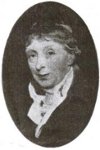 A
number of the
houses were originally occupied by Scandinavian timber merchants. In
the chapter
on Wellclose Square in their informative book Wapping 1600-1800: A Social
History of an Early Modern London Maritime Suburb
(East London Historical Society 2009) Derek Morris and
Ken Cozens list
a number of local families, identified from insurance policies, court
records and wills, including
A
number of the
houses were originally occupied by Scandinavian timber merchants. In
the chapter
on Wellclose Square in their informative book Wapping 1600-1800: A Social
History of an Early Modern London Maritime Suburb
(East London Historical Society 2009) Derek Morris and
Ken Cozens list
a number of local families, identified from insurance policies, court
records and wills, including| References to Wolff
in John Wesley's Journal: 1783: 28.02, 04.06,
17.12; 1784: 18.02; 1785: 04.08 (Balham); 1786: 04.01; 1787: 03.01,12.12
(Ballam) (Testament); 1788: 14.01 (Bal[h]am.
sermon), 18.01 (Mrs Wolff), 21.02, (Bal[h]am (sermon), 13.11; 1789: 20.01 (letters),
01.12 (Bal[h]am); 1790: 20.01, 16.02
(Tuesday: I
retired to Balham for a few days, in order to finish my sermons and put
all my things in order), 18.02 (Thursday: 3
with Mrs Wolff, Wandswor[th], 8 Balham, supper), 02.10, 06.11(at Mr. Wolff's, christened), 29.12;
1791: 31.01. |
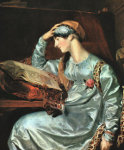 The
next generation departed somewhat from Lutheran / Methodist piety, and
were less fortunate in business. Georg's son Jens, who inherited the consulate
from his father, has been described as a'virtually unrewarded' hero of
the Danes - see Den
Danske Kirke i London 1692-1992
- and was the last person to be interred in the vault below the Danish
church, in 1845, then in the hands of Bo'sun Smith with whom he had
been in conflict. His wife
Isabella had a long-standing
affair with Sir
Thomas Lawrence,
from some time after he began his portrait of her in 1803 until her
divorce in 1813; two years later his picture [left], depicting her as the
Ethyrean Sibyl from the Sistine chapel, apparently examining a book of
Michaelangelo's engravings, was exhibited at the Royal Academy, and is
now at the Art Institute of Chicago. (Some observers note that she
appears to have no clavicle.) Georg's daughter Elizabeth married John Dorville,
but had an equally nororious liasion with the noted naturalist George
Montague, producing two children, who took her husband's surname -
Henry and Elizabeth Dorville.
The
next generation departed somewhat from Lutheran / Methodist piety, and
were less fortunate in business. Georg's son Jens, who inherited the consulate
from his father, has been described as a'virtually unrewarded' hero of
the Danes - see Den
Danske Kirke i London 1692-1992
- and was the last person to be interred in the vault below the Danish
church, in 1845, then in the hands of Bo'sun Smith with whom he had
been in conflict. His wife
Isabella had a long-standing
affair with Sir
Thomas Lawrence,
from some time after he began his portrait of her in 1803 until her
divorce in 1813; two years later his picture [left], depicting her as the
Ethyrean Sibyl from the Sistine chapel, apparently examining a book of
Michaelangelo's engravings, was exhibited at the Royal Academy, and is
now at the Art Institute of Chicago. (Some observers note that she
appears to have no clavicle.) Georg's daughter Elizabeth married John Dorville,
but had an equally nororious liasion with the noted naturalist George
Montague, producing two children, who took her husband's surname -
Henry and Elizabeth Dorville.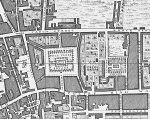
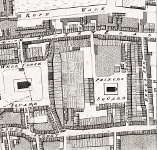 Left are
detailed maps of the area by John Rocque (1742) and Horwood
(1792). In
1815
Nightingale
described it as a
pretty little neat square. But it was not all
housing: a sugar
refinery
was built in the square by 1794
(and by 1854 there were five). There premises, at no.48, were used
until 1851 in turn by Pritzler, Engell, Martineau, and Henrickson. It
was still listed as a sugarhouse in the 1861 and 1871 censuses, but was
taken over, together with no.49,
as a pickle factory by George Whybrow
and Sons, variously described as export
oilmen, oil merchants
and Italian warehousemen.
The firm began trading around 1825 and had other premises at 4 Minories
and 10 Royal Mint Street. In the 1830s Eliza Whybrow insured 1
Cannon Street Road as an oil
warehouse keeper. One of their sites had a steam-powered lift
between the floors. They manufactured pickles, sauces, bottled fruits
and other goods, imported capers, salad oil and castor oil and exported
to the colonies, especially Australia - detailed in this advertisement from the Australian Handbook of
1877, which pictures the Wellclose Square works and quotes from a
testimonial in The Grocer
of 22 May 1875:
Left are
detailed maps of the area by John Rocque (1742) and Horwood
(1792). In
1815
Nightingale
described it as a
pretty little neat square. But it was not all
housing: a sugar
refinery
was built in the square by 1794
(and by 1854 there were five). There premises, at no.48, were used
until 1851 in turn by Pritzler, Engell, Martineau, and Henrickson. It
was still listed as a sugarhouse in the 1861 and 1871 censuses, but was
taken over, together with no.49,
as a pickle factory by George Whybrow
and Sons, variously described as export
oilmen, oil merchants
and Italian warehousemen.
The firm began trading around 1825 and had other premises at 4 Minories
and 10 Royal Mint Street. In the 1830s Eliza Whybrow insured 1
Cannon Street Road as an oil
warehouse keeper. One of their sites had a steam-powered lift
between the floors. They manufactured pickles, sauces, bottled fruits
and other goods, imported capers, salad oil and castor oil and exported
to the colonies, especially Australia - detailed in this advertisement from the Australian Handbook of
1877, which pictures the Wellclose Square works and quotes from a
testimonial in The Grocer
of 22 May 1875: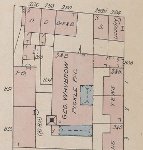 George died in 1873, and the 1881 census shows 48 & 49 Wellclose
Square as uninhabited - they had moved to new premises at 290 Cable
Street, between Bewley and Albert Streets, shown right on Goad's 1899 insurance map
prior to closure. His relatives Francis and Henry took on the
business for a time, but their partnership was dissolved in 1885.
Francis continued to run it; an attempt to re-finance it failed in
1897. It was
wound up in 1899, and an order of the Chancery court was made the
following March for the sale of the lease,
goodwill, stock-in-trade and fixtures of the business of Pickle
Manufacturers for many years carried on by George Whybrow Limited, and
their predecessors at 290 Cable-street Shadwell together with trade marks, plant and
machinery and the option of purchasing current book debts.
George died in 1873, and the 1881 census shows 48 & 49 Wellclose
Square as uninhabited - they had moved to new premises at 290 Cable
Street, between Bewley and Albert Streets, shown right on Goad's 1899 insurance map
prior to closure. His relatives Francis and Henry took on the
business for a time, but their partnership was dissolved in 1885.
Francis continued to run it; an attempt to re-finance it failed in
1897. It was
wound up in 1899, and an order of the Chancery court was made the
following March for the sale of the lease,
goodwill, stock-in-trade and fixtures of the business of Pickle
Manufacturers for many years carried on by George Whybrow Limited, and
their predecessors at 290 Cable-street Shadwell together with trade marks, plant and
machinery and the option of purchasing current book debts.| Or take the case of George Whybrow, Limited, where investors are asked to acquire, at a cost of £60,000, the business of a pickle, sauce, &c, manufacturer. As the business was established in the beginning of the present century, it would obviously be possible to show what the profits have been over a series of years; but instead of any particulars of the kind, we are treated to an estimate of what the company is going to earn in the future, and are asked to reflect upon the profitable natures of such joint-stock companies as Maple and Co., J. & P. Coats, Harrod's Stores, A. and F. Pears, the leading drapery companies, Price's Candle Co., Bryant and May's, and Guinness. Could anything be more absurd? |
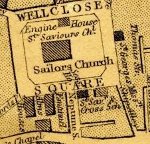 As
well as those linked to the Bo'sun Smith's church, the Square
housed other hostels
and other welfare organisations, including the Jewish Joel Emanuel Almshouse (a trust
which continues to the present day, based in north London) - shown on
1868 map right in the
south-west corner - and at no.32 the Hand in Hand Home for Aged and Decayed
Tradesmen,
founded in 1840 and previously based at 5 Duke's Place from 1843, and
22 Jewry Street from 1850 before moving to the Square in 1854, and
again in 1878 to 23 Well Street, Hackney.
This was one of a trio of organisations set up to protect members of
the Jewish community, for whom care and respect for the elderly and
needy is a core priority; the Poor Law
system failed to meet their social, religious and dietary needs. The
other two were the Widow's Home Asylum (founded 1843, and from
1857-1880 at 67 Great Prescott [Prescot] Street - more here)
and the Jewish Workhouse or Home (1871). The three later came together
in Hackney and Stepney Green and merged in 1894, moving to Nightingale
Lane in Wandsworth Common in 1907. (Now known as Nightingale,
in 2001 it was the largest Jewish residential and nursing home in
Europe. Ted 'Kid' Lewis, a local Jewish boxer, whose story is noted here, was a resident
from 1966 until his death in 1970.) See here for a Jewish
orphanage elsewhere in the parish which also became the basis of a
present-day trust elsewhere.
As
well as those linked to the Bo'sun Smith's church, the Square
housed other hostels
and other welfare organisations, including the Jewish Joel Emanuel Almshouse (a trust
which continues to the present day, based in north London) - shown on
1868 map right in the
south-west corner - and at no.32 the Hand in Hand Home for Aged and Decayed
Tradesmen,
founded in 1840 and previously based at 5 Duke's Place from 1843, and
22 Jewry Street from 1850 before moving to the Square in 1854, and
again in 1878 to 23 Well Street, Hackney.
This was one of a trio of organisations set up to protect members of
the Jewish community, for whom care and respect for the elderly and
needy is a core priority; the Poor Law
system failed to meet their social, religious and dietary needs. The
other two were the Widow's Home Asylum (founded 1843, and from
1857-1880 at 67 Great Prescott [Prescot] Street - more here)
and the Jewish Workhouse or Home (1871). The three later came together
in Hackney and Stepney Green and merged in 1894, moving to Nightingale
Lane in Wandsworth Common in 1907. (Now known as Nightingale,
in 2001 it was the largest Jewish residential and nursing home in
Europe. Ted 'Kid' Lewis, a local Jewish boxer, whose story is noted here, was a resident
from 1966 until his death in 1970.) See here for a Jewish
orphanage elsewhere in the parish which also became the basis of a
present-day trust elsewhere.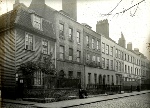
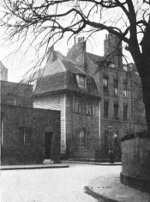
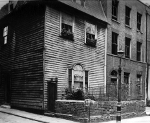
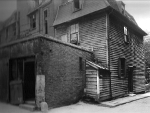
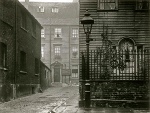
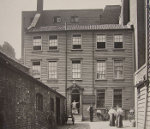 In
the 19th century no.6 housed
the office of the St George-in-the-East Poor Law Guardians. Two timber-framed
buildings reflecting the 18th century maritime history of the area, and
which remarkably survived later reconstruction, were the cottage at
no.26, at the corner of Stable
Yard (with a Venetian attic window) [pictures
1 & 2; 3 & 4 show front and rear in 1943], and no.27, in the yard behind, a
'colonial-style' house of four storeys and cellar [pictures 5 & 6 (1 Sept 1911) - the sign reads Everett & Co,
though earlier the sugar bakers Ellerman had been based here].
In
the 19th century no.6 housed
the office of the St George-in-the-East Poor Law Guardians. Two timber-framed
buildings reflecting the 18th century maritime history of the area, and
which remarkably survived later reconstruction, were the cottage at
no.26, at the corner of Stable
Yard (with a Venetian attic window) [pictures
1 & 2; 3 & 4 show front and rear in 1943], and no.27, in the yard behind, a
'colonial-style' house of four storeys and cellar [pictures 5 & 6 (1 Sept 1911) - the sign reads Everett & Co,
though earlier the sugar bakers Ellerman had been based here]. Famous
residents
Down
the
years Wellclose Square had a number of notable residents, and became
something of a
haven for free-thinkers, before it fell into decline. Indeed, from
1744-62 it housed a small dissenting academy, in the home of Dr
Samuel Morton Savage (1721-91).
Students boarded with families, and the library and lectures
were in the house. Morton taught classics and mathematics, and Dr David
Jennings, the Principal, taught theology.
Other notable residents included:
 Sir Felix Feast, brewer, freeman and
briefly Sheriff of London; here in the early years of the 18th century
he brought up Richard Cooper
(1700-64), orphaned at the age
of nine, who moved to Edinburgh around 1727 and as
an engraver with architectural interests became a significant figure in
the Scottish enlightenment; he had also been associated with the
Swedish artist George
Englehart Schröder (1684-1750), who drew Cooper's portrait [right] before returning to Sweden
in 1725 and may have had connections with the Swedish Church
in Prince's Square (for more details on all this, see Dr Joe Rock's
site here).
Sir Felix died intestate in 1724, provoking a Chancery case (5 April
1726) about the provision made at the time of his marriage for his wife
(she lived until in 1755) and future children.
Sir Felix Feast, brewer, freeman and
briefly Sheriff of London; here in the early years of the 18th century
he brought up Richard Cooper
(1700-64), orphaned at the age
of nine, who moved to Edinburgh around 1727 and as
an engraver with architectural interests became a significant figure in
the Scottish enlightenment; he had also been associated with the
Swedish artist George
Englehart Schröder (1684-1750), who drew Cooper's portrait [right] before returning to Sweden
in 1725 and may have had connections with the Swedish Church
in Prince's Square (for more details on all this, see Dr Joe Rock's
site here).
Sir Felix died intestate in 1724, provoking a Chancery case (5 April
1726) about the provision made at the time of his marriage for his wife
(she lived until in 1755) and future children. 
 Thomas Bowrey (1662-1713), sea
captain and free merchant,
probably from a Wapping family, who travelled and traded extensively in
the East Indies between 1669-88; he then married his cousin Mary
Gardiner, daughter of a Wapping apothecary, and settled in Wellclose
Square until their deaths (she outlived him by two years). He was a
Younger Brother of Trinity
House, and is particularly remembered for
producing the first English-Malay
dictionary in 1701 [his map of Malay-speaking areas right]. He also published travel
writings, including a Geographical
Account of the Countries round the Bay of Bengal 1669-1679, which
includes this illustration [far
right] and an account of how on the Bay of Biscay he and his
colleagues observed the effect of communal drug-taking (bhang, made from crushed cannabis
pods mixed with milk) and each bought a pint to try for themselves:
Thomas Bowrey (1662-1713), sea
captain and free merchant,
probably from a Wapping family, who travelled and traded extensively in
the East Indies between 1669-88; he then married his cousin Mary
Gardiner, daughter of a Wapping apothecary, and settled in Wellclose
Square until their deaths (she outlived him by two years). He was a
Younger Brother of Trinity
House, and is particularly remembered for
producing the first English-Malay
dictionary in 1701 [his map of Malay-speaking areas right]. He also published travel
writings, including a Geographical
Account of the Countries round the Bay of Bengal 1669-1679, which
includes this illustration [far
right] and an account of how on the Bay of Biscay he and his
colleagues observed the effect of communal drug-taking (bhang, made from crushed cannabis
pods mixed with milk) and each bought a pint to try for themselves:
| It
Soon tooke its Operation Upon most of us, but merrily, Save upon two of
our Number, who I suppose feared it might doe them harme not beinge
accustomed thereto. One of them Sat himselfe downe Upon the floore, and
wept bitterly all the Afternoone, the Other terrified with feare did
runne his head into a great Mortavan Jarre, and continue in that
posture 4 hours or more; 4 or 5 of the number lay upon the Carpets
(that were Spread in the roome) highly Complimentinge each Other in
high termes, each man fancyinge himself noe lesse than an Emperour. One
was quarrelsome and fought with one of the wooden Pillars of the Porch,
until he had left himselfe little Skin upon the knuckles of his
fingers. My Selfe and one more Sat sweating for the Space of 3 hours in
Exceeding Measure ... |
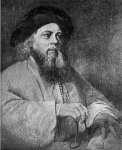 Dr
Hayyim
Samuel Jacob Falk
(c1708-1782) [right] was a
Kabbalistic rabbi and alchemist. Charged with
sorcery in his native Westphalia, he fled to London and settled in
Wellcose Square in 1742 where he lived until his death. The Jews of
London called him the 'Baal Shem of London' because of his alleged
miraculous or magical powers involving the divine Name. He kept a diary
of dreams and the Kabbalistic names of angels, now held in the library
of the United Synagogue in London.
Dr
Hayyim
Samuel Jacob Falk
(c1708-1782) [right] was a
Kabbalistic rabbi and alchemist. Charged with
sorcery in his native Westphalia, he fled to London and settled in
Wellcose Square in 1742 where he lived until his death. The Jews of
London called him the 'Baal Shem of London' because of his alleged
miraculous or magical powers involving the divine Name. He kept a diary
of dreams and the Kabbalistic names of angels, now held in the library
of the United Synagogue in London.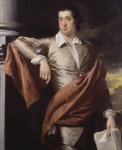
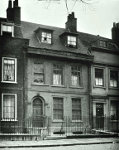
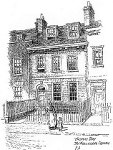 Thomas
Day (1748-89), author, politician and disciple
of
Rousseau, though he lived most of later life at the family estate in
Barehill, Berkshire, was born in Wellclose Square, at a house which
went with his father's
job as 'Collector of the Customs Outward in the Port of London'.
variously numbered 31, 32 and 36 - right,
in a drawing from John Adcock Famous London
Houses and Literary Shrines of London (Dent 1912), and
photo of 1920 - which until it was demolished bore a blue plaque. Day's
1773 poem The Dying Negro,
written with John Bicknell, was an early inspiration to the
anti-slavery
campaign, and The
Devoted Legions (1776) argued for the rights of
the American colonists. He is most remembered for his children's book The
History of Sandford and Merton (1783) which
espouses Rousseau's ideals. Far right
is a 1770 portrait by Joseph Wright (National Portrait Gallery). [In
the 1820s and 1830s no.32 was
the home of an engineer, John Hague
(c1781-1857) who registered various patents, including for
sugar-blowing and hydraulic machinery, but was declared bankrupt in
1845, then living at Rotherhithe; it later housed a Jewish hostel.]
Thomas
Day (1748-89), author, politician and disciple
of
Rousseau, though he lived most of later life at the family estate in
Barehill, Berkshire, was born in Wellclose Square, at a house which
went with his father's
job as 'Collector of the Customs Outward in the Port of London'.
variously numbered 31, 32 and 36 - right,
in a drawing from John Adcock Famous London
Houses and Literary Shrines of London (Dent 1912), and
photo of 1920 - which until it was demolished bore a blue plaque. Day's
1773 poem The Dying Negro,
written with John Bicknell, was an early inspiration to the
anti-slavery
campaign, and The
Devoted Legions (1776) argued for the rights of
the American colonists. He is most remembered for his children's book The
History of Sandford and Merton (1783) which
espouses Rousseau's ideals. Far right
is a 1770 portrait by Joseph Wright (National Portrait Gallery). [In
the 1820s and 1830s no.32 was
the home of an engineer, John Hague
(c1781-1857) who registered various patents, including for
sugar-blowing and hydraulic machinery, but was declared bankrupt in
1845, then living at Rotherhithe; it later housed a Jewish hostel.]
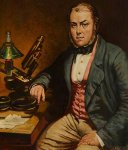 The
next residents of no.50 were
scientists John
Thomas Quekett (1815-61) [right], founder of the Royal
Microscopical Society, and his brother (also a histologist and
miscroscopist) Edwin John
Quekett. They came to live next door to their older brother William
at no.51, who was the first
Vicar of Christ Church Watney Street. Here
is an 1841 paper by Edwin for the Medical Gazette, 'On
the Production of Ergot of Rye'.
The
next residents of no.50 were
scientists John
Thomas Quekett (1815-61) [right], founder of the Royal
Microscopical Society, and his brother (also a histologist and
miscroscopist) Edwin John
Quekett. They came to live next door to their older brother William
at no.51, who was the first
Vicar of Christ Church Watney Street. Here
is an 1841 paper by Edwin for the Medical Gazette, 'On
the Production of Ergot of Rye'.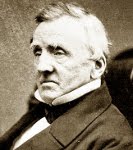
 Dr
Nathaniel
Bagshaw Ward
(1791-1868) invented around 1829 the terrarium or 'Wardian case'
[examples left], a
dry version of
an aquarium, because his ferns were being
poisoned by
the London air. He was the son and assistant of Stephen Smith Ward, who
practised medicine in the Square, and succeeded him in the practice.
Dr
Nathaniel
Bagshaw Ward
(1791-1868) invented around 1829 the terrarium or 'Wardian case'
[examples left], a
dry version of
an aquarium, because his ferns were being
poisoned by
the London air. He was the son and assistant of Stephen Smith Ward, who
practised medicine in the Square, and succeeded him in the practice.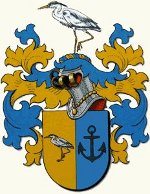 Jan
Hendrik [John Henry] Vorstius (1827-1879) was the son of a wealthy Amsterdam
stockbroker - family arms right
- but having settled in London and anglicized his forenames, in 1851
married Charlotte Crawford, née Vardey, a 23-year old widow with a 2
year old son, at St John of Wapping. She was living with her stepfather
William Johnson at 83 St George Street, described in the 1851 census as
a beer seller; Jan/John was
more grandly described in the wedding
register as a licensed victualler.
The had six children, baptized at
St John of Wapping. By 1855 (when their son Alfred Edward was born - he
married in 1871) they were living at no.10
Wellclose Square and he was a cab
proprietor; the same profession was given in the 1871 census,
when they were at 224 St George Street, though in 1861 (at Hill Street)
he was described as a coachman.
What brought him to the area, and why
did he stay? More details here.
Jan
Hendrik [John Henry] Vorstius (1827-1879) was the son of a wealthy Amsterdam
stockbroker - family arms right
- but having settled in London and anglicized his forenames, in 1851
married Charlotte Crawford, née Vardey, a 23-year old widow with a 2
year old son, at St John of Wapping. She was living with her stepfather
William Johnson at 83 St George Street, described in the 1851 census as
a beer seller; Jan/John was
more grandly described in the wedding
register as a licensed victualler.
The had six children, baptized at
St John of Wapping. By 1855 (when their son Alfred Edward was born - he
married in 1871) they were living at no.10
Wellclose Square and he was a cab
proprietor; the same profession was given in the 1871 census,
when they were at 224 St George Street, though in 1861 (at Hill Street)
he was described as a coachman.
What brought him to the area, and why
did he stay? More details here.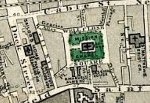 1872: an article claimed that a notice at
the entrance to the Prussian Eagle
tavern, in Ship Alley (a meeting-place for Germans, with a
well-used dance hall upstairs, with one of the various
4- or 6-piece
German bands providing music) read All persons are requested,
before entering the dancing saloon, to leave at the bar their pistols
and knives, or any other weapon they may have about them. This
may be a myth, but Melville McNaughton, later Assistant Commissioner at
New Scotland
Yard, recalled visiting as a young constable, when dancing
was carried on by German ladies, and sailors of all nationalities, and
the sight of a drawn knife or two was not infrequent. [1872 map
right shows the various
institutions.]
1872: an article claimed that a notice at
the entrance to the Prussian Eagle
tavern, in Ship Alley (a meeting-place for Germans, with a
well-used dance hall upstairs, with one of the various
4- or 6-piece
German bands providing music) read All persons are requested,
before entering the dancing saloon, to leave at the bar their pistols
and knives, or any other weapon they may have about them. This
may be a myth, but Melville McNaughton, later Assistant Commissioner at
New Scotland
Yard, recalled visiting as a young constable, when dancing
was carried on by German ladies, and sailors of all nationalities, and
the sight of a drawn knife or two was not infrequent. [1872 map
right shows the various
institutions.] 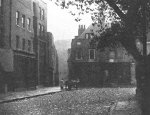
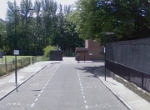
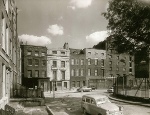

 See
here for 1911
and 1934 accounts of the
Square.
See
here for 1911
and 1934 accounts of the
Square. 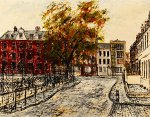
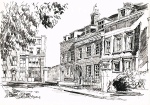 1967 & 1968:
here are two wistful drawings showing the potential of the Square and
what might have been saved. The first is by Noel Gibson, and the second
by Geoffrey Fletcher who wrote The
devastation of the square was pitiful to see. I only saw one man all
the time I paced the square, and he had one foot in the grave. The
April evening was chill and the sky overcast, but a blackbird warbled
in the plane trees, introducing impromptu variations and evidently
trying to keep his courage up. The half dozen Georgian terraced houses
left on the north side looked indescribably weary and exhausted, their
bricks crumbling and their stucco returning to sand. Grass was coming up on the pavement.
1967 & 1968:
here are two wistful drawings showing the potential of the Square and
what might have been saved. The first is by Noel Gibson, and the second
by Geoffrey Fletcher who wrote The
devastation of the square was pitiful to see. I only saw one man all
the time I paced the square, and he had one foot in the grave. The
April evening was chill and the sky overcast, but a blackbird warbled
in the plane trees, introducing impromptu variations and evidently
trying to keep his courage up. The half dozen Georgian terraced houses
left on the north side looked indescribably weary and exhausted, their
bricks crumbling and their stucco returning to sand. Grass was coming up on the pavement.
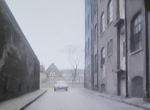 The story of the
demolition of the remaining houses, and the 'redevelopment' of the
area, is told here. In a shed at the rear
of no.37 an oak carved
sacrament cupboard or aumbry,
dating from the early 16th century, possibly French in origin, was
found. Right is a still from
'Poppy', a 1975 episode of The
Sweeney,
showing St Paul's School in the background, and a view of the site
between St Paul's School and The Highway where subterranean electrical
cabling [far right] is under
way. Public Projects, a local
network, is campaigning for a creative use
of this site when this work is completed, hoping to build on Tower Hamlets'
new conservation
area of 2008 centred on Wilton's Music Hall and Wellclose
Square. For further comment,
see Will Palin on 'This unfortunate and
ignored locality' in Spitalfields Life (December
2012).
The story of the
demolition of the remaining houses, and the 'redevelopment' of the
area, is told here. In a shed at the rear
of no.37 an oak carved
sacrament cupboard or aumbry,
dating from the early 16th century, possibly French in origin, was
found. Right is a still from
'Poppy', a 1975 episode of The
Sweeney,
showing St Paul's School in the background, and a view of the site
between St Paul's School and The Highway where subterranean electrical
cabling [far right] is under
way. Public Projects, a local
network, is campaigning for a creative use
of this site when this work is completed, hoping to build on Tower Hamlets'
new conservation
area of 2008 centred on Wilton's Music Hall and Wellclose
Square. For further comment,
see Will Palin on 'This unfortunate and
ignored locality' in Spitalfields Life (December
2012).
Homepage | About Us | Services & Events
| Church &
Churchyard |
History
Newsletters & Sermons | Contacts,
Links & Registers | Giving | Picture
Gallery |
Site Map